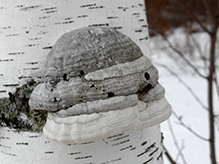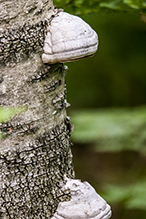Hoof Fungus
(Fomes fomentarius)
Conservation • Description • Habitat • Ecology • Use • Distribution • Taxonomy
|
|
||||||||||||||
Description |
Hoof Fungus fruiting body (conk) is a 2″ to 8″ wide, ¾″ to 4¾″ thick polypore. The fruiting body is hoof-shaped, rounded and curved downward on top, flat or slightly angled upward below. There is no stalk. The upper surface is concentrically zoned and hairy when young. The zones are grooved and vary in color in shades of gray and brownish-gray. It soon becomes gray and hairless. The margin is whitish and velvety on actively growing conks. The underside is whitish. The pore tubes are not layered (stratified). The flesh is hard and cinnamon brown. When cut in cross section there are no white lines (mycelial threads) visible. An individual conk can survive for years, even decades, forming a new ridge or furrow each year. It is found on standing or fallen dead trees or on the trunk of a living tree. |
Similar Species |
Willow Bracket (Phellinus igniarius) old conks are black and often cracked above. The margin and undersurface are light brown and velvety on actively growing conks. The pores are stratified. The flesh in cross section shows white mycelial threads. |
Habitat and Hosts |
Usually birch, but also other hardwoods Hoof Fungus causes white trunk rot on hardwood trees. It turns the wood into a soft, white, spongy mass. |
Ecology |
Season |
Year-round but grows mostly in early summer and autumn |
Use |
Season |
Another common name for Hoof Fungus is Tinder Polypore, named for its most common usage, as tinder for starting fires. Otzi the Iceman, the 5,000-year-old mummy found in the Alps in 1991, was carrying four pieces of it. |
Distribution |
||
|
Sources |
|
| 3/22/2025 | ||
Occurrence |
||
Very common and widespread |
||
Taxonomy |
|
Kingdom |
Fungi (Fungi) |
Subkingdom |
Dikarya |
Phylum |
Basidiomycota (club fungi) |
Subphylum |
Agaricomycotina (jelly fungi, yeasts, and mushrooms) |
Class |
Agaricomycetes (mushrooms, bracket fungi, puffballs, and allies) |
Subclass |
incertae sedis (uncertain placement) |
Order |
Polyporales (shelf fungi) |
Family |
Polyporaceae (bracket fungi) |
Genus |
Fomes |
Subordinate Taxa |
|
|
|
Synonyms |
|
Agaricus fomentarius Boletus fomentarius Boletus ungulatus Elfvingia fomentaria Elfvingiella fomentaria Fomes excavatus Fomes fomentarius var. leuciticus Fomes introstuppeus Fomes inzengae Fomes mirus Ochroporus fomentarius Placodes fomentarius Polyporus fomentarius Polyporus introstuppeus Polyporus inzengae Polyporus mirus Polyporus populinus Pyrenium fomentarium Pyropolyporus fomentarius Scindalma fomentarium Scindalma introstuppeum Scindalma mirum Ungularia albescens Ungularia populina Ungulina fomentaria |
|
Common Names |
|
Hoof Fungus Tinder Conk Tinder Fungus Tinder Polypore True Tinder Polypore |
|
Glossary
Conk
A shelf-like, bracket-shaped fruiting body of certain fungi.
Mycelium
The vegetative part of a fungus; consisting of a mass of branching, thread-like hyphae, through which a fungus absorbs nutrients from its environment; and excluding the fruiting, reproductive structure.
Polypore
A bracket fungi. A fungi that produces its spores in pores on the underside of a woody fruiting body (conk).
Visitor Photos |
||
Share your photo of this fungus. |
||
This button not working for you? |
||
Dan W. Andree |
 |
Fungi on a dead birch tree... This was on a dead birch tree along a small creek in rural Norman Co. Mn. 3-18-25. It was on a steep embankment and I couldn’t get the best shot of it but found it interesting how it blend in with the tree etc. |
Luciearl |
||
Found on birch snag |
||
 |
 |
|
Robert Briggs |
 |
MinnesotaSeasons.com Photos |
||
 |
 |

Slideshows |
Hoof Tinder Bracket Fungus |

|
About
Bracket fungus. Hoof Tinder Fungus Fomes fomentarius |
Fomes fomentarius - fungi kingdom |
About
Published on Jan 23, 2015 Fomes fomentarius - fungi kingdom |

Visitor Videos |
||
Share your video of this fungus. |
||
This button not working for you? |
||
|
Other Videos |
||
Tinder Fungi (Fomes fomentarius) on Birch Tree |
About
Published on Jun 3, 2012 Photographed at the Rydell NWR, Minnesota (03 June 2012). |
Fomes fomentarius Tonderzwam |
About
Uploaded on Jul 11, 2009 Tonderzwammen op beuk |
Fomes fomentarius (Ίσκα) |
About
Published on May 16, 2015 |

Visitor Sightings |
||
Report a sighting of this fungus. |
||
This button not working for you? |
||
| Luciearl 1/15/2020 |
Location: Cass County Found on birch snag |
 |
| Robert Briggs 10/20/2016 |
Location: Afton State Park, Southern River Trail |
 |
MinnesotaSeasons.com Sightings |
||

Created: 10/26/2016 Last Updated: © MinnesotaSeasons.com. All rights reserved. |

